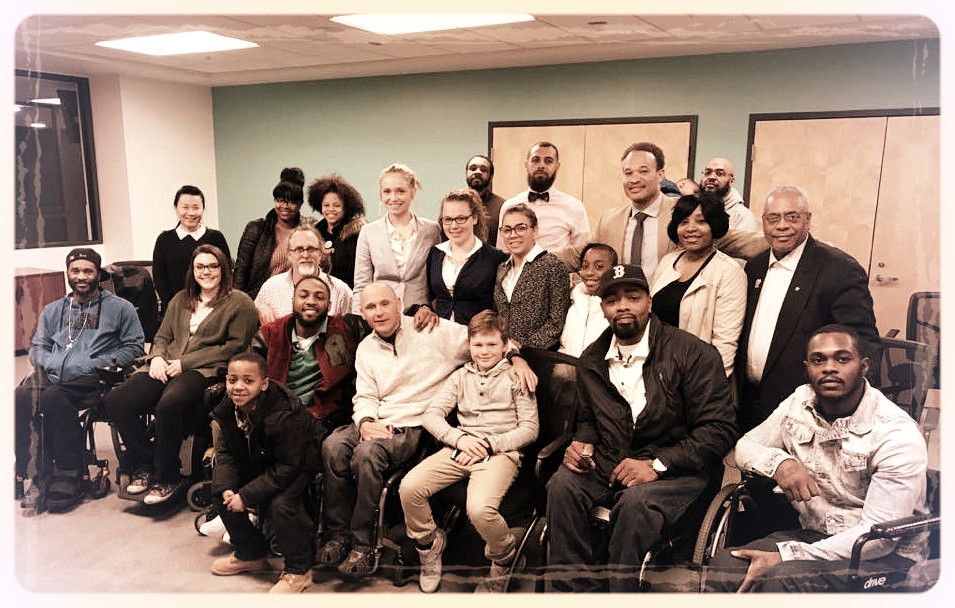Dec 18, 2023
Crossing the Vastness: An Adaptive Team’s Journey from Rim to Rim of the Grand Canyon
by Jason Stoffer
Back in early October of this year, I joined my fellow paraplegic adventure companion and U2FP colleague, Quinn Brett, along with some other great friends, in an attempt to traverse the Grand Canyon, rim to rim to rim (R2R2R). This is a bucket list item for many distance runners and a feat that Quinn herself had completed prior to her injury. This time we would attempt to do it on handcycles.
Almost every year since we met at Craig Hospital, where we were recovering after our injuries, Quinn and I have done something physically challenging together. We do it as a reminder that we are still alive. We also do it to remind ourselves and others that there is still a place for our adventurous spirits in the natural world. For Quinn, this was a celebration of her alive day, October 11, the day she didn’t die from a climbing fall off El Capitan in Yosemite National Park.
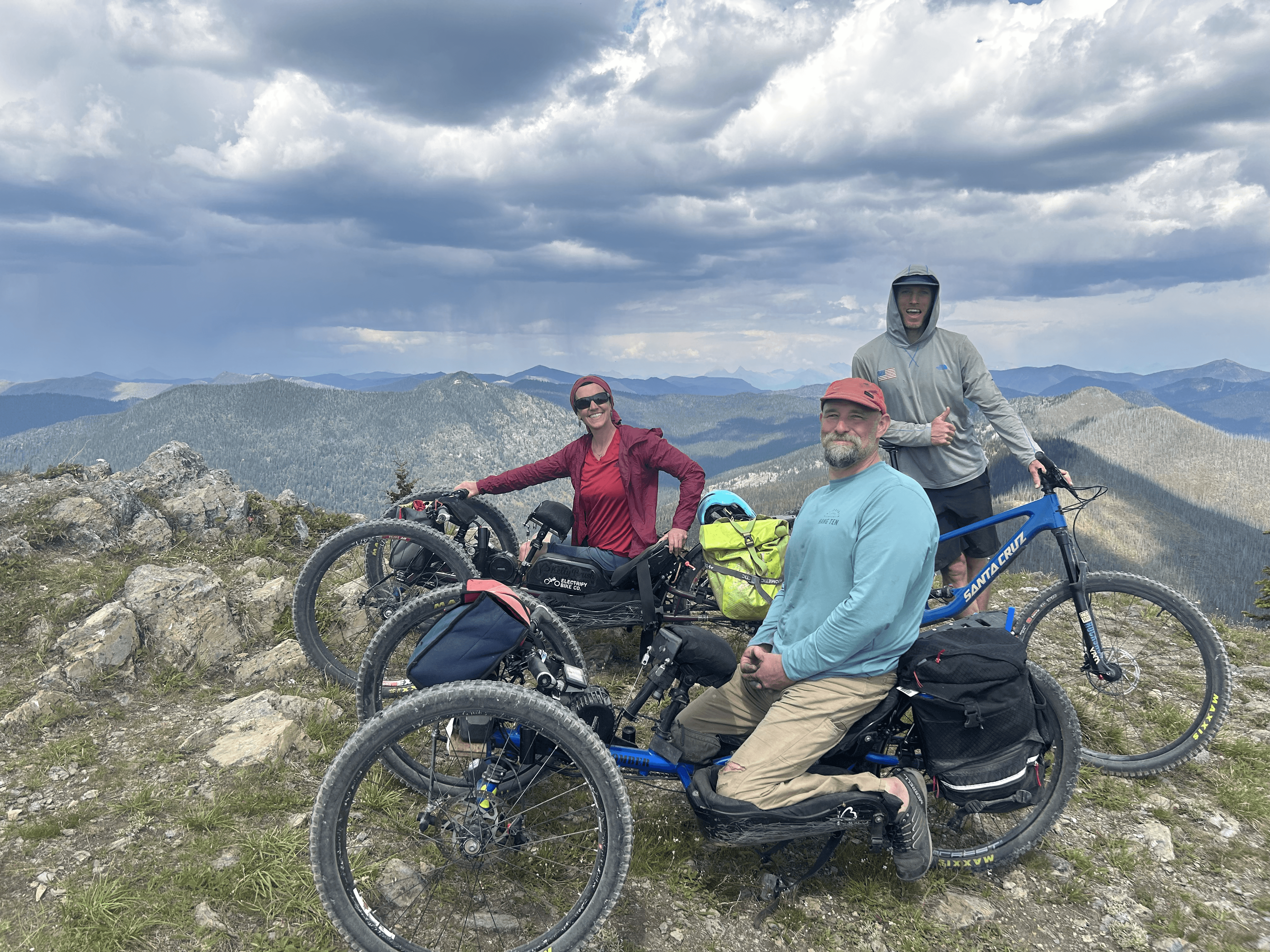
Quinn Brett, Jason Stoffer and Robert Prechtl on Mount Marston in Montana earlier this year. Photo credit: Quinn Brett.
My motivation was to shine a light on our work with U2FP, specifically our CAN activism, which is difficult to fund since it is technically lobbying, but enormously impactful. To date U2FP’s CAN has passed state legislative bills in four states that have resulted in meaningful interventions to restore function in over 200 persons with a spinal cord injury. And we’ve allocated almost $35M in research that was chosen by individuals with an SCI alongside top scientists. So, I made our Grand Canyon journey my Team U2FP Freestyle Challenge for the year, raising dollars and awareness for our cause.
For the uninitiated, R2R2R involves dropping into the Canyon, crossing the Colorado River, ascending out of the Canyon on the other side and then repeating that journey in reverse. You use either the Bright Angel Trail or the South Kaibab Trail to descend from the South Rim and use the North Kaibab Trail to ascend to the North Rim.
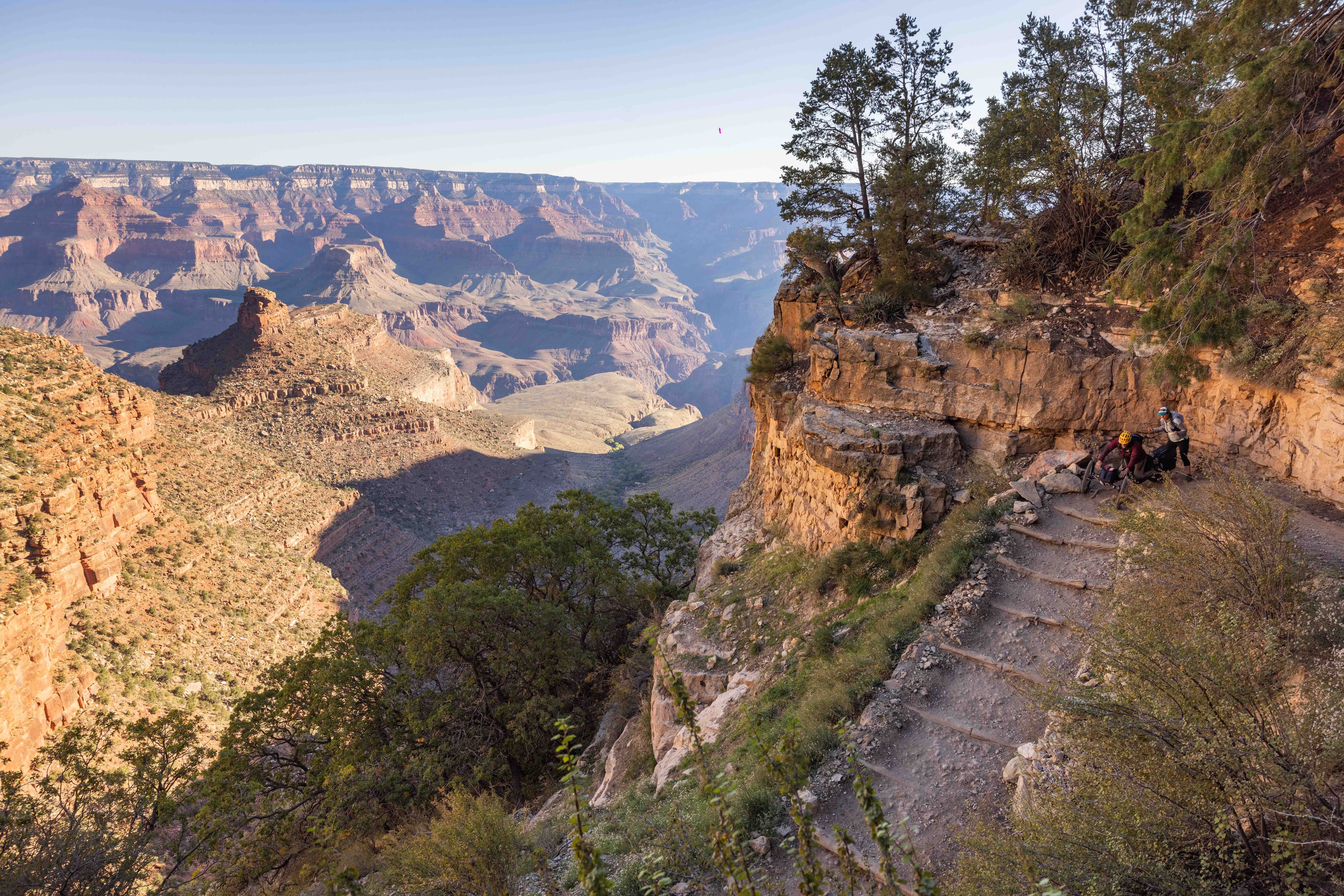
The beginning of our journey as we drop into Bright Angel Trail on day 1. Photo credit: Robert Prechtl.
The round trip can be 44 to 50 miles, depending on the route you choose. The descent from the South Rim to the Colorado River is about 4,500 vertical feet. The ascent to the North Rim is about 6,000 ft, which is more than a vertical mile. Temperatures vary but can be below freezing at the top to greater than 100 degrees F at the bottom. The trail width aims to be around 4 feet, but with erosion and washouts, it becomes quite a bit narrower. A good portion of the trail is subject to fall hazard exposure and drop-offs of several hundred feet. Drinking water is sparse and sun exposure is ever present. The trail steepness, which can be up to a 16% grade, is broken up by thousands of rock and log steps, water diversion channels and limestone retaining slabs. These obstacles vary from 6 inches to 2 feet high.
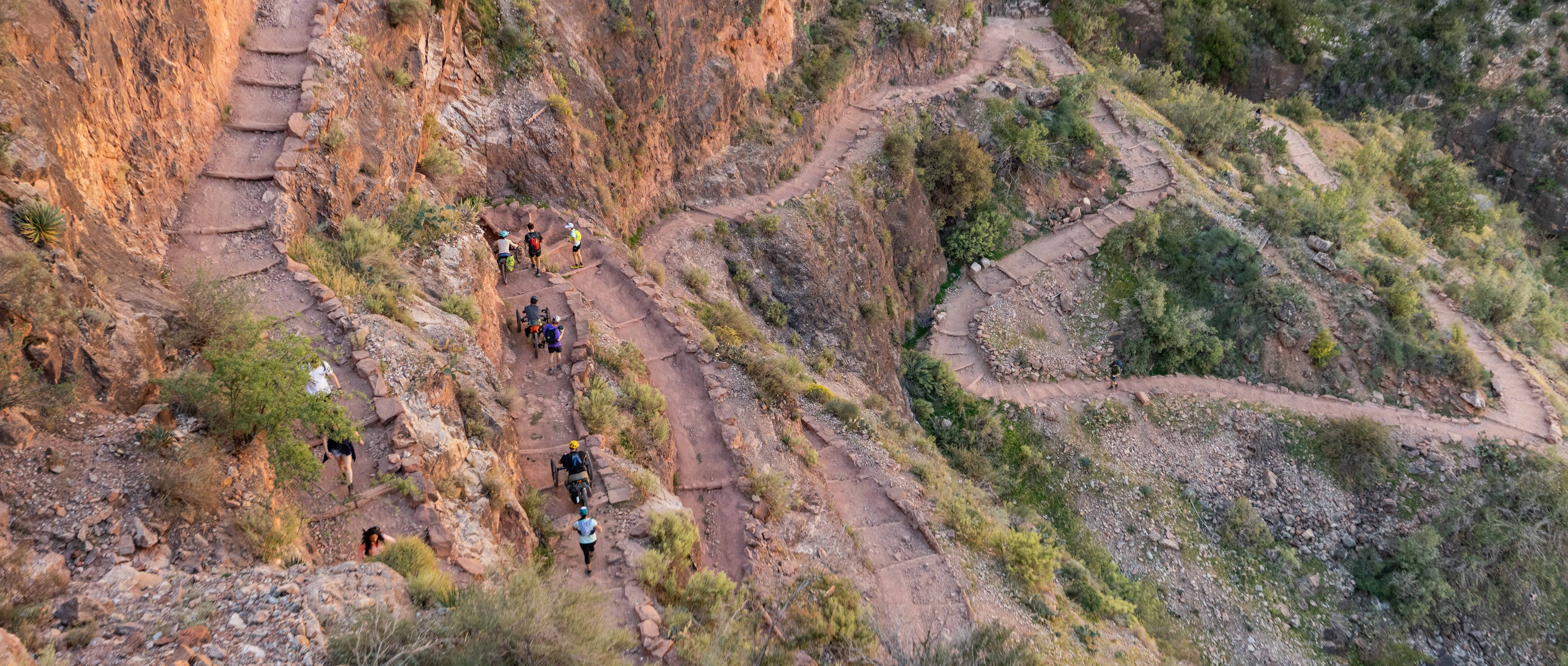
Overhead shot as we descend into the canyon. Photo credit: Robert Prechtl.
All of these things we knew before pointing our wheels downhill: Quinn had run the route and I’d been down to the Colorado River enough to know that it was possible, but both of these experiences were viewed through the lens of our pre-injury, able-bodied selves.
On Saturday, October 8, 2023 we started our journey. We made good time on our early morning descent. Spirits were high but held in check, knowing that we were on a schedule, and I couldn’t help thinking that with every drop down a step, we were incurring a kind of debt, which would need to be paid by the whole team in the very near future. About half way down I lost my rear brake, having jostled an air bubble loose in the hydraulic line. We spent about 30 minutes trying to fix it to no avail. We had to keep moving. Immediately afterward, we encountered a very tight, rocky and technical section just above “The Devil’s Corkscrew” which sapped energy and time. When we made it to the Colorado River, the first bridge we encountered was too narrow for the trikes and required us to add more miles, elevation and exposure to our route and cross at the stock bridge farther upriver.

Jason navigating the usual debris on the trail. Photo credit: Robert Prechtl.
It was probably 2pm at the bottom of the Canyon and the day was heating up. We were already behind schedule and it was here that gravity, our most helpful companion, would become our foe. Needless to say, the hardest part was still ahead. After crossing the Colorado river, we filled up with water, found some scant shade and crammed down calories to make the push.

Jason looking out as he crosses the Colorado River on a stock bridge. Photo credit: Kim Givler
The next section was rolling and lovely along the valley bottom of Bright Angel creek. The setting sun augmented the bright reds of the sedimentary rock surrounding us. My mindset was a mix of awe and worry. As a group, we just kept pushing, but I think we were all beginning to get concerned at that point. When we stopped again for water, Quinn gathered everyone around for a little chat about expectations, realities, etc. We all decided that completing an R2R2R, at that point, was not going to be a possibility in the timeframe we allotted. We all committed to just safely getting out of the Canyon.
We continued on but we were losing daylight and were encountering sections of washed-out, high consequence terrain. Through these sections our options were either to stay on the bike and tip sideways at a nearly 45 degree angle while three of our buddies each pushed downward on each wheel for traction and rolled forward, or get off the bike and butt scoot, crawl or piggy back while someone rolled or carried the trike. Add to all of this fatigue and our trike power-assist battery levels reaching zero, and the obvious course of action was to stop for the night and bivouac alongside the trail. Fortunately, we found the Manzanita Rest Area, which had water and which was large enough to accommodate us. At that point we were 5 miles and 2000 vertical feet from the top.
Quinn still had some battery left so she and some of the crew carried on for a while until it just became too sketchy. She wound up sleeping in a little alcove, cut out of the steep vertical limestone wall. Our running buddies made it to the top of the North Rim to gather up supplies for the night and batteries for the next day and returned to Manzanita. I just want to emphasize here that they motored another 10 miles that night, on top of a 20 mile day.

Narrow exposed trail on day 2. Note the red circle, which marks where Quinn slept the previous night.
Photo credit: Scotty Rogers.
Before supplies showed up everyone was doing their best to stay warm. The temps had dropped to around 40 degrees and we had minimal extra gear with us. I had a mid-weight jacket and a knit hat. With a spinal cord injury there is always the fear of pressure sores. Quinn and I, and our friend Ben all figured out independently to take our knee pads out and put them under our hips and shoulders. It was a fitful night’s sleep. I was starting to shiver intermittently. I was worried about sores. Because we were on the side of the trail, we were being passed by what seemed like hundreds of headlamp-donned R2R2R runners. When I was conscious, I caught their murmurs: “Do you think that guy is OK?”, “Should we check on him?”, “How did that contraption get down here?”. Our friends showed up with supplies around midnight and with an extra layer, the sleep was a little better.
The next morning we set off for the North Rim. The grade from there to the top immediately steepened, with only short sections of moderate grade. This is where we ran into more rock and log steps of varying size, and unlike the Bright Angel Trail, short sections of trail that were too narrow for our trikes. It would be hands-on for our companions for the majority of the day. When we encountered the 2 foot retaining stones, it took two people to lift the front of the trike up on the step. Then, one or two people would lift the back of the trike up and onto the step. This was repeated endlessly.

“All hands on deck.” Photo credit: Stacy Dorais.
At about mid-day, and under a full and unrelenting sun, my battery was dead again due to the necessary use of throttle for climbing technical terrain. Our herculean buddies were starting to wear down too. We were still about 1000 feet from the top. We were running out of water and the signs of heat challenge to the body were becoming evident. We sent out a satellite message to our support up top that we needed batteries and water. Fortunately, we found a switchback with deep and growing shade, and decided to stay there and make a recovery.
We were a sight to see: five men - two with spinal cord injuries - laying on the ground, under wheeled contraptions, unconscious. After about an hour of sleep in the cool shade we woke up and tried to make a plan. We hadn’t heard back from our support folks. We had no idea how Quinn and the girls were doing. We would ask southbound passers-by for information on the girls. If the conversations were extra friendly, we would ask for a little water. Eventually a plan was conceived. One of our strongest runners, Scotty, would head up to the top for batteries and water. Our para buddy, Ben would continue on with runners, Robbie and Joe. I would sit tight at the “begging corner” till a fresh battery and crew arrived.
While I sat there I was able to take in the Canyon for the first time. I chatted with people passing by. I also considered the current situation with my spinal cord injury and the fact that I was sitting in a place that would be impossible to get out of on my own power. I considered my utter reliance on this team, and reflected on how my loss of physical independence had given way to a new phase in my life: one of trust and vulnerability. I began ruminating on urinary tract infections and how I was certain to get one because I had run out of catheters the night before. I had been using my last one over and over, trying to keep it sanitary amidst the red chalk dust that was everywhere. I thought about the fact that an “invol” (aka “shitting yourself”) was also imminent because I had to skip my bowel routine the night before as well. I wondered how much damage my skin incurred by sleeping on the ground the night before, unable to feel if bone was wearing through tissue. I wondered just how infected my right palm might get from the assortment of prickly pear cactus needles that were embedded in it from a fall I had taken the day before.
A few hours later I heard a conversation from familiar voices coming from above and getting closer. It was Kim and Stacey. They had come to keep me company and bring the news from the North Rim. They told me how the day went and how Quinn and Ben had made it to the top; how the battery I was waiting for had accidentally wound up in a vehicle that headed back to the South Rim and how that battery was now three hours away. As we conversed, storm clouds rolled in accompanied by rain, lightning and thunder. The girls suggested that we try to make it to the Supai Tunnel which was a few hundred yards up the trail. I got the trike and we squeezed out the last of the battery's juice to get to the shelter of the tunnel. We decided to nap and get as much rest as possible before the last push to the top.
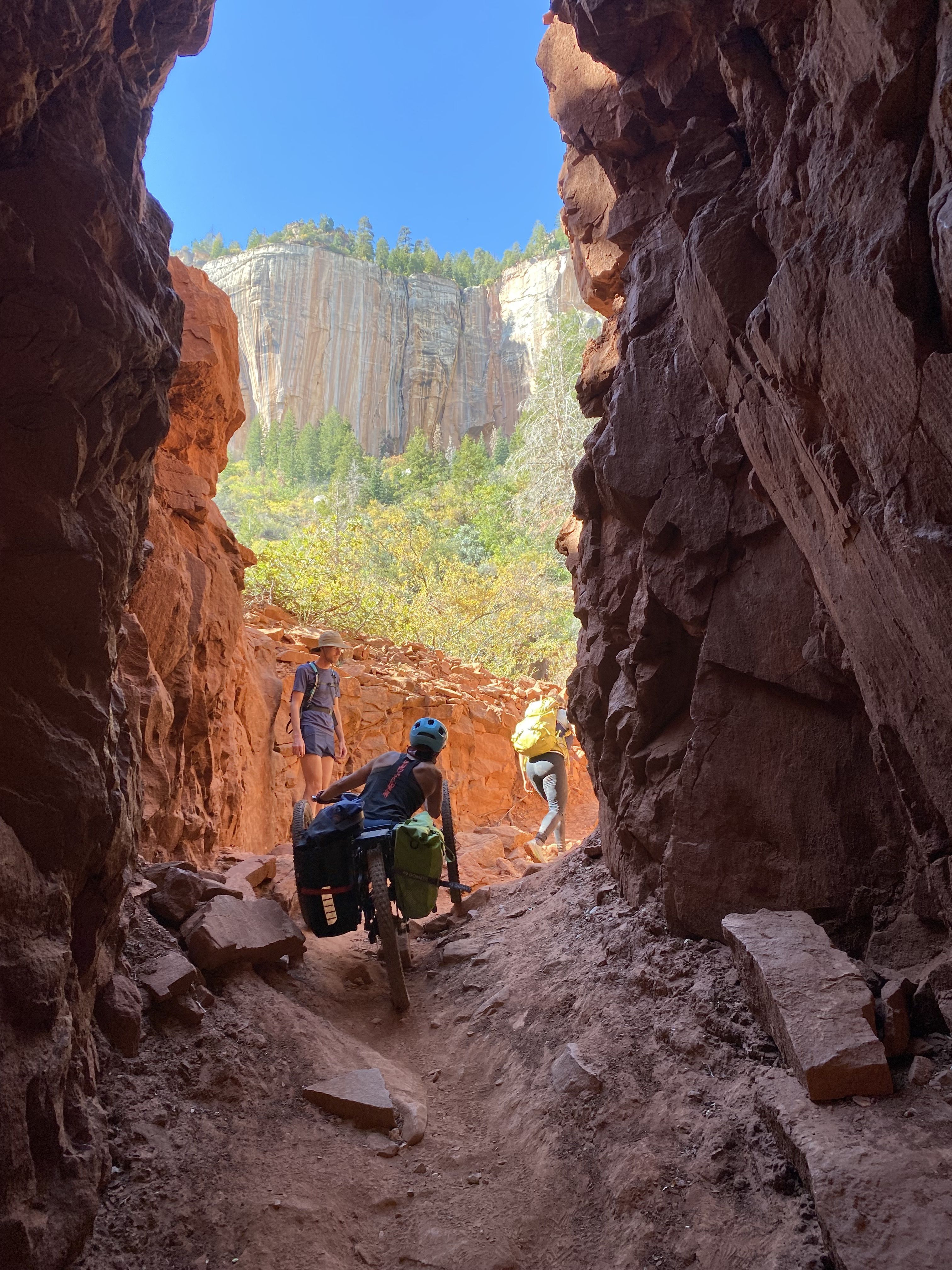
Coming out of the Supai Tunnel. Photo credit: Stacy Dorais.
We were awakened by a bellow from Robbie and Joe harkening, “FRIENDS!!” They had cannibalized a battery and tray from one of the trikes that made it up top. The idea was that we could “plug and play” with my trike, but it was the wrong connection. I happened to have some electrical connectors in my tool bag, so we spliced the connections together to make it work and off we went. The next 3 hours were smooth and surprisingly fun. Half of the journey was spent in the dusk and half in the darkness. We all entered a kind of flow state of forward movement. My mood lightened with the prospect that I might actually make it out the “Big Ditch”. At the top we very briefly celebrated, stuffed ourselves into the vehicles and began our 5 hour drive home.
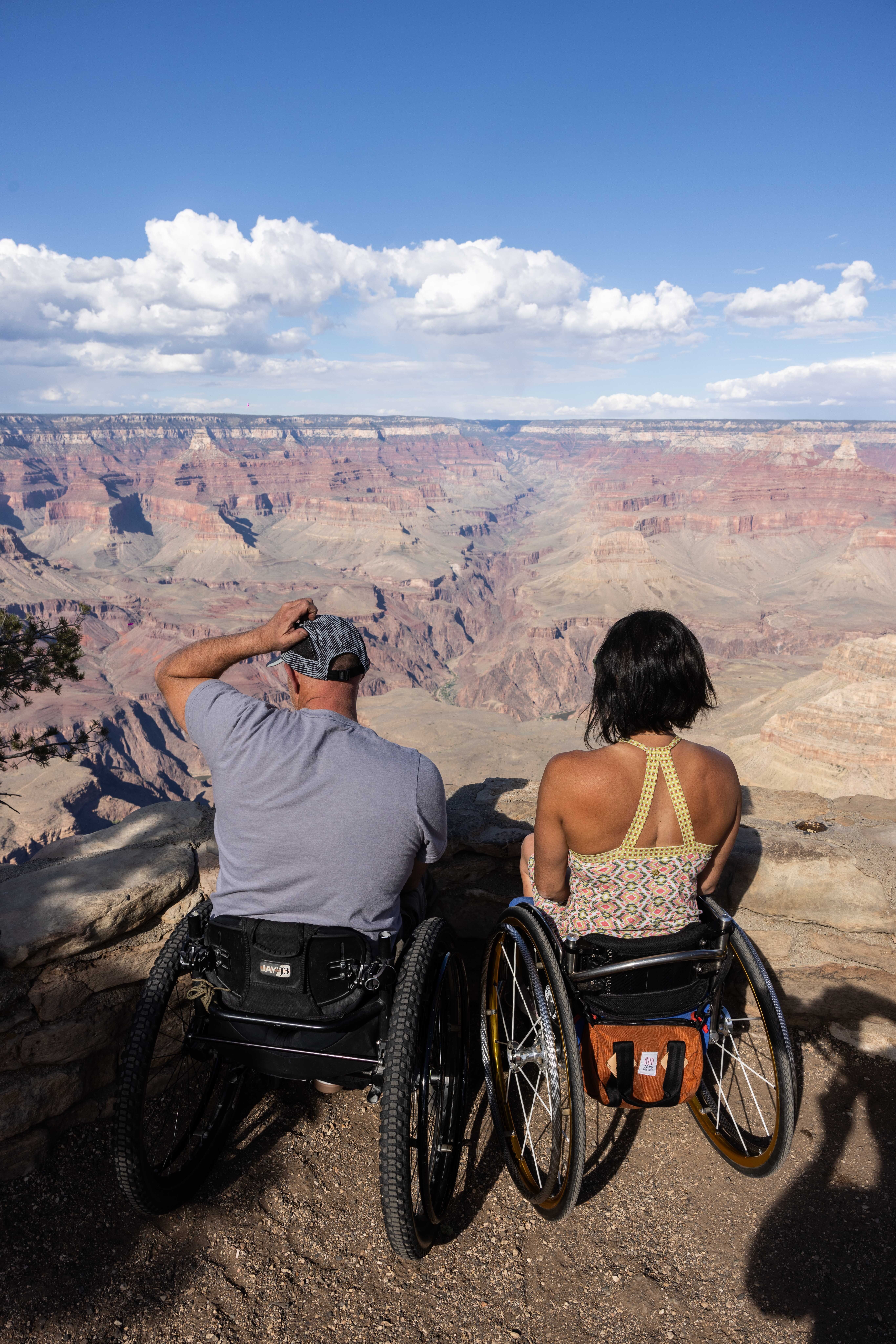
Reflecting after the journey. Photo credit: Robbie Prechtl.
And that is how we got in and out of the Grand Canyon. I’m not sure I’ll ever be finished processing what this journey meant. A few words that come to mind are friendship, teamwork, audacity, advocacy and grit. This trail was not built for us or our mobility contraptions. The reactions of passers-by was always one of peculiarity and curiosity. It was not built for us but we inhabited that space, regardless.
This reflects our mission at U2FP in so many ways: to realize cures for our community that may seem audacious and impossible. Yet our advocates continue to make progress, regardless of the obstacles in their path. The research space was not built for us or our voice, yet we show up, regardless. The path toward functional recovery will be a difficult one, for certain. We will continue to encounter obstacles along the way, but the richness of success will far outweigh our temporary difficulties.
I am glad you are with us. Please join us in being audacious, through advocacy, research and/or financial support.
PS - If you appreciate U2FP's ongoing work to speed functional recovery for the SCI community, consider making a donation here.

